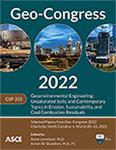Water Retention and Hydraulic Conductivity Characteristics of Ponded Fly Ash
Publication: Geo-Congress 2022
ABSTRACT
Federal regulations concerning disposal of coal combustion products (CCPs) have prompted action across the United States to cap and close older, unlined coal ash storage ponds that do not meet the new federal, state, and local regulations. During operations, dewatering is performed to increase the strength and stability of the ponded ash, so that heavy construction equipment can work on the ash surface. However, some deposits of fly ash are not easily dewaterable and exhibit significant water retention capacities. This work seeks to identify why coal fly ash has some unusual water retention characteristics. First, particulate mixes of fine sand and highly porous additives were tested for saturated hydraulic conductivity. Results indicated that including activated carbon or diatomaceous earth in the sand matrix decreased the saturated hydraulic conductivity by one to two orders of magnitude. Second, the saturated and unsaturated characteristics of samples of highly water-retentive ponded fly ash (FA) were investigated. The FA samples (treated and untreated) had a soil water characteristic curve of a silt. The high-residual water content of the ash was found to be due to the combination of water-retentive, highly porous diatoms and kaolinite. The main conclusion from this work is that the presence of porous unburned carbons, porous diatoms, and kaolinite contributed to the increased water-retentive capacities of ponded fly ash and ash/granular mixtures.
Get full access to this article
View all available purchase options and get full access to this chapter.
REFERENCES
Abhijit, D., and Sreedeep, S. (2015). “Evaluation of measurement methodologies used for establishing water retention characteristic curve of fly ash.” Journal of Testing and Evaluation, 43(5), 20130091. https://doi.org/10.1520/JTE20130091.
ASTM. (2003). “Standard Test Methods for Measurement of Hydraulic Conductivity of Saturated Porous Materials Using a Flexible Wall Permeameter.” ASTM Standards for Testing and Evaluation, 1–23. doi:https://doi.org/10.1520/D5084-03.1.3.2.
ASTM. (2008). “Standard Test Methods for Determination of the Soil Water Chararcteristic Curve for Desorption Using a Hanging Column, Pressure Extractor, Chilled Mirror Hygrometer, and/or Centrifuge.” ASTM Standards for Testing and Evaluation, 22. https://doi.org/10.1520/D6836-02R08E02.characteristic.
ASTM D2487. (2006). “Standard Practice for Classification of Soils for Engineering Purposes (Unified Soil Classification System).”, 1–12.
Burger, B. C. A., and Shackelford, C. D. (2001). “Soil-water chracteristic curves and dual porosity of sand – diatomaceous earth mixtures.” Journal of Geotechnical and Geoenvironmental Engineering, 790–800.
Dumenu, L., Pando, M. A., Ogunro, V. O., Daniels, J. L., Moid, M. I., and Rodriguez, C. (2017). “Water retention characteristics of compacted coal combustion residuals.” Geo-Frontiers 2017, 403–413.
EPA. (2015). Disposal of coal combustion residuals from electric utilities. Federal Register.
Fan, S. S., Chang, F. H., Hsueh, H. T., and Ko, T. H. (2016). “Measurement of total free iron in soils by H2S chemisorption and comparison with the citrate bicarbonate dithionite method.” Journal of Analytical Methods in Chemistry, 1–7. doi:https://doi.org/10.1155/2016/7213542.
Van Genuchten, M. T. (1980). “A closed-form equation for predicting the hydraulic conductivity of unsaturated soils.” Soil S, 44, 892–898.
Khire, M. V., Saghaei, B., and Grohol, B. (2020). “Saturated and unsaturated hydraulic properties of ponded coal fly ash.” GeoCongress 2020 GSP 319, 430–439. doi:https://doi.org/10.1061/9780784482797.054.
Kim, B., Prezzi, M., and Salgado, R. (2007). “Geotechnical properties of fly and bottom ash mixtures for use in highway embankments.” Journal of Geotechnical and Geoenvironmental Engineering, 133(7), 903–904. doi:https://doi.org/10.1061/(asce)1090-0241(2007)133:7(903).
Lu, N., and Likos, W. J. (2004). Unsaturated Soil Mechanics. John Wiley and Sons, Inc.
Malaya, C., and Sreedeep, S. (2012). “Critical evaluation of the drying water retention characteristics of a Class F Indian fly ash.” Journal of Materials in Civil Engineering, 24(4), 451–459. doi:https://doi.org/10.1061/(asce)mt.1943-5533.0000395.
Palmer, B. G., Edil, T. B., and Benson, C. H. (2000). “Liners for waste containment constructed with class F and C fly ashes.” Journal of Hazardous Materials, 76(2–3), 193–216. doi:https://doi.org/10.1016/S0304-3894(00)00199-0.
Phadnis, H. S., and Santamarina, J. C. (2011). “Bacteria in sediments: Pore size effects.” Geotechnique Letters, 1(4), 91–93. doi:https://doi.org/10.1680/geolett.11.00008.
Ren, X. W., and Santamarina, J. C. (2018). “The hydraulic conductivity of sediments: A pore size perspective.” Engineering Geology, Elsevier, 233(December), 48–54. doi:https://doi.org/10.1016/j.enggeo.2017.11.022.
Singh, J., and Singh, S. K. (2019). “Geotechnical Characterization and WRCC for Spatially Varied Pond Ash within an Ash Pond.” Indian Geotechnical Journal, Springer India, 49(3), 341–351. doi:https://doi.org/10.1007/s40098-018-0340-4.
Take, W. A., Beddoe, R. A., Davoodi-Bilesavar, R., and Phillips, R. (2015). “Effect of antecedent groundwater conditions on the triggering of static liquefaction landslides.” Landslides, 12(3), 469–479. doi:https://doi.org/10.1007/s10346-014-0496-7.
Webb, R. W., Stormont, J. C., Stone, M. C. S., and Thomson, B. M. (2014). “Characterizing the unsaturated and saturated hydraulic properties of coal combustion by-products in landfills of northwestern New Mexico.” American Society of Mining and Reclamation, 3(1), 70–99. doi:https://doi.org/10.21000/JASMR14010070.
Wirth, X. (2019). Beneficial use of biomass and coal combustion residuals.
Wirth, X., Glatstein, D. A., and Burns, S. E. (2019). “Mineral phases and carbon content in weathered fly ashes.” Fuel, Elsevier, 236, 1567–1576. doi:https://doi.org/10.1016/j.fuel.2018.09.106.
Yeboah, N. N. N., Shearer, C. R., Burns, S. E., and Kurtis, K. E. (2014). “Characterization of biomass and high carbon content coal ash for productive reuse applications.” Fuel, Elsevier Ltd, 116(X), 438–447. doi:https://doi.org/10.1016/j.fuel.2013.08.030.
Young, S. C., Schmidt-Petersen, R., Ankeny, M., and Stephens, D. B. (1993). “Physical and hydraulic properties of fly ash and other by-products from coal combustion.”.
Information & Authors
Information
Published In
Copyright
© 2020 ASCE.
History
Published online: Mar 17, 2022
Authors
Metrics & Citations
Metrics
Citations
Download citation
If you have the appropriate software installed, you can download article citation data to the citation manager of your choice. Simply select your manager software from the list below and click Download.
